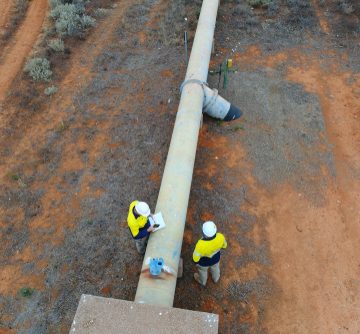What is Digital Radiography (DR)?
Digital radiography is a non destructive testing (NDT) technique that builds on traditional radiography. The technique utilises an active matrix array of ray detectors instead of film or a computer to capture an image. DR NDT is used to create an image of the inside of a pipeline or other structure.
X-Ray photons pass through an object and a Scintillator converts X-rays into visible light. Light is then translated into a digital image by a capture device – flat panel detectors. This NDT technique is similar to traditional radiography in terms of its physics. It only requires minor upgrades to existing hardware to perform to a better standard.
Novo is an Israeli company that solely manufactures non destructive testing equipment. Portable X-Ray systems are their primary product offering. NDT supplies Novo digital radiographic equipment to the Australian market. We have written the following article to provide more insight into Novo’s digital radiographic equipment: its features, benefits and applications.
Novo Product Features
Novo’s core technology is digital radiography systems. The devices are compact, lightweight, rugged, weather proof and include wireless and battery operation capabilities. These characteristics allow for the inspection of pipes and other pipeline equipment in tight spaces. Older NDT equipment struggled to operate in such areas.
The array of detectors in Novo’s NDT technology is one of the finest in the world. Similarly, the images quality produced by Novo’s digital radiographic equipment is the highest of any device on the market.
Benefits
The advantages of using Novo’s digital radiography are manifold. In general, the technology is far more efficient than traditional non destructive testing radiography techniques.
- Easy transport and setup is enabled with digital radiography. Due to the portable nature of Novo’s products, they are far easier to set up before inspections commence.
- Faster Radiography Image Processing is possible using digital arrays. The mechanism of generating an image following a scan is much faster than older technology. Ray images are also higher resolution images.
- Only single Site Visits are needed to inspect a pipeline. Because digital images can be stored on electronic media, there is no need to return to sites for a reshoot. Images can be retrieved digitally and viewed offsite after pipe inspections. The entire inspection does not need to be completed in real time.
- Safer Radiation Levels are used. The dose of ray energy used to inspect the inside of pipes is much safer than in film or computer radiography. This reduces risk for operators.
- No Additional Image Processing Technology Needed. Finally, It is no longer necessary to use either a dark room nor chemicals to process images when using this technology. Ray film becomes obsolete with the availability of digital technology.
Applications
Digital radiographic NDT technology is used in situations where pipes are in service. The most common applications, therefore, of this NDT technology are in the oil and gas industry.
Oil wells, refineries and power stations all require frequent NDT testing. Inspections can happen at any stage in the oil pipeline. The initial transportation pipeline of crude oil, from to the locations where the final oil product is refined all need evaluation.
Pipes, no matter where they are located, are frequently subject to a range of problems that can slow down operations. Operations can grind to a halt when total failures happen. Pipe inspections are carried out by engineers to detect corrosion and clogging. Engineers also inspect the welds between components to ensure structural stability using NDT equipment.
Contact NDT Equipment Sales today if you are looking for digital radiographic NDT equipment. We also stock a dynamic range of other NDT equipment. We are open for business 7:30 to 4:00pm Monday to Friday. Call us on (02) 9524 0558 to place an order for digital radiographic equipment today.


